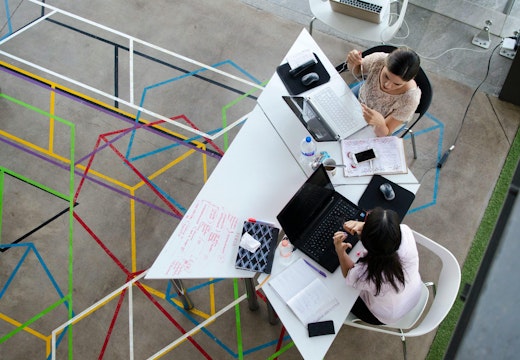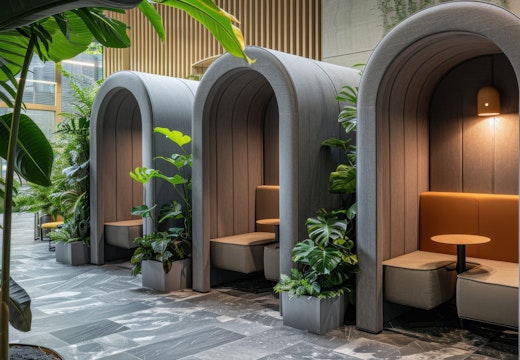Against the grain: research reinforces message that wood is good
What is the effect of introducing wood finishes in your workplace? New research from Finland builds on a wealth of positive scientific evidence showing that worker stress levels can be reduced
Research has consistently shown that using wood with visible grain in office spaces – on walls, ceilings, floors, for furniture or in art – can elevate experiences at work.
Now a new study from a team of researchers in Finland has reinforced this message that wood is good. Led by Ann Ojala of Finland’s Natural Resources Institute, the researchers evaluated the implications of using wood with visible grain in offices by gathering data in two rooms – one with wooden elements and a control room without wood.
Study participants were asked to perform cognitive tasks on a computer to imitate typical office work and increase their stress level and then had a rest period in an armchair in the same room. The study, which has been published in the Journal of Environmental Psychology, found that anxiety felt by participants was clearly lower at the end of the experiment in the wooden room (where 50 per cent of the surface material was pinewood) than in the control room. However, sustained attention to the response task were similar in both rooms.
Positive impact
The effect on lowering stress levels in spaces where wood is visible mirrors the results of earlier studies. Douglas and colleagues (2022) looked at previous research studies and concluded that ‘The use of wood materials has . . . been found to have a positive impact on occupants’ physiological response, affective state, and cognitive performance both through visual exposure in person and in virtual reality.’
Awada and associates (2023) focused on workplace stressors and found that visual stimulation from wood wall panels resulted in lower tension and fatigue compared to non-wooden indoor environments. Also, salivary cortisol concentration was lower in workers engaging in an office-like environment with oak wood furniture than when engaging in spaces with non-wooden furniture.
Burnard and Kutnar (2020) studied stress levels in offices with different sorts of furniture, comparing human stress responses in experimental office settings with and without wood as indicated by salivary cortisol concentration. Overall, stress levels were lower in the office-like environment with oak wood than in a control room of white furniture, but there was no detectable difference in stress levels between an office with American walnut and the control room.
The researchers concluded that it is possible to use wood furniture as a passive environmental intervention to help office workers cope with stress. However, when selecting wood furniture, it is important to consider visual characteristics and how they interact with other elements of the indoor environment such as lighting. The oak furniture used in this experiment was noticeably lighter in colour and produced a noticeably brighter environment than the office with walnut furniture, even though lighting levels were the same in each room.
Use in moderation
Lipovac and Burnard (2021) reviewed published research related to seeing wood and concluded that ‘current evidence suggests that visual wood exposure may improve certain indicators of human stress’. However, use of wood in offices should be in moderation according to research by Zhu, Wang, and Zhao (2023), which found that ‘people exhibit higher aesthetic evaluations of light and medium wood-coloured office spaces and prefer spaces with low wood coverage.’
Finally, a research review published by Stora Enso (2020) reports that ‘wood has beneficial effects . . . It helps reduce stress, blood pressure and heart rate as well as allowing for more creativity and productivity in the workplace. Wood is also an important part of what’s called biophilic design; our desire to be connected with the natural environment.’
Read more of the latest research insights from Sally Augustin in Research Round-up, her regular column in the Innovation Zone here.
Research sources
Mohamad Awada, Burcin Becerik-Gerber, Ruying Liu, Mirmahdi Seyedrezaei, Zheng Lu, Matheos Xenakis, Gale Lucas, Shawn Roll, and Shrikanth Narayanan. 2023. ‘Ten Questions Concerning the Impact of Environmental Stress on Office Workers.’ Building and Environment, vol. 229, 109964
Michael Burnard and Andreja Kutnar. 2020. ‘Human Stress Responses in Office-Like Environments with Wood Furniture.’ Building Research and Information, vol. 48, no. 3, pp. 316-330
Isabella Douglas et al. 2022. ‘Physical Workplaces and Human Well-Being: A Mixed-Methods Study to Quantify the Effects of Materials, Windows, and Representation on Biobehavioral Outcomes.’ Building and Environment, vol. 224, 109516
Dean Lipovac and Michael Burnard. 2021. ‘Effects of Visual Exposure to Wood on Human Affective States, Physiological Arousal and Cognitive Performance: A Systematic Review of Randomized Trials.’ Indoor and Built Environment, vol. 30, no. 8, pp. 1021-1041
Ann Ojala, Joel Kostensalo, Jari Viik, Hanna Matilainen, Ida Wik, Linda Virtanen, and Riina Muilu-Makela. 2023. ‘Psychological and Physiological Effects of a Wooden Office Room on Human Well-Being: Results from a Randomized Controlled Trial.’ Journal of Environmental Psychology, vol. 89, 102059
Stora Enso. 2020. ‘10 Reasons Why Wooden Buildings Are Good for You and the Scientific Research to Back It Up’
Tsunetsugu, Y. Miyazaki, and H. Sato. 2007. ‘Physiological Effects in Humans Induced by the Visual Stimulation of Room Interiors with Different Wood Quantities.’ Journal of Wood Science—The Japan Wood Research Society, vol. 53, pp.11-16.
Yiwei Zhu, Qiang Wang, and Feng Zhao. 2023. ‘Wood in Office Spaces: The Impact of Different Wooden Furniture on Aesthetic Evaluation.’ Frontiers in Psychology, vol. 13, 986627








